Instructions
Click on a date on the timeline to read about key events which may have influenced the poets. This is a brief outline of events. For a more in-depth view visit this link.
1789
The Storming of the Bastille
The Storming of the Bastille, on the 14th July 1789, marked a turning point in the French Revolution and subsequently became symbolic of this turbulent period.

Henry Singleton [Public domain], via Wikimedia Commons
1794
Blake publishes Songs of Innocence and Experience
Although Blake’s Songs of Innocence and Experience sold fewer than 30 copies in his lifetime, it is widely regarded today as a seminal work in the fields of writing and the visual arts in the Romantic Age.

Songs of Innocence – William Blake [Public domain], via Wikimedia Commons
1797
Jane Austen completes Pride and Prejudice; Coleridge writes The Rime of the Ancient Mariner and Kubla Khan.
Pride and Prejudice, initially conceived as a novel entitled ‘First Impressions’, is widely considered by modern critics to be a work that transcended the ‘novel of the day’ to become a literary classic.

By Pickering & Greatbatch [Public domain], via Wikimedia Commons
1798
Wordsworth writes Tintern Abbey and with Coleridge publishes Lyrical Ballads
Lyrical Ballads, a collection of Wordsworth’s and Coleridge’s poetry, is generally considered to be a landmark of Romanticism, a book which marked the beginning of a new literary age.

"Lyrical Ballads" by William Wordsworth (1770-1850) and Samuel Taylor Coleridge (1772-1834). - University of Leeds. Licensed under Public Domain via Wikimedia Commons
1804
Napoleon proclaimed Emperor in France
On the 2nd of December 1804 Napoleon crowned himself Emperor Napoleon I at Notre Dame de Paris. According to legend, during the coronation he snatched the crown from the hands of Pope Pius VII and crowned himself, thus displaying his rejection of the authority of the Pontiff.

by Jacques-Louis David - The York Project. Licensed under Public Domain via Wikimedia Commons
1805
Wordsworth completes the twelve-book Prelude; Battle of Trafalgar
The Prelude, generally considered to be Wordsworth’s magnum opus, was first completed in 1805 yet different versions were to follow for the rest of the poet’s life.

The Battle of Trafalgar (1822) by William Turner - Downloaded from http://www.nmm.ac.uk/mag/images/700/BHC0565_700.jpg. Via Wikimedia Commons
1807
Abolition of slave-trading in British ships; Wordsworth publishes Poems in Two Volumes
The abolition of slave-trading in British ships was met with a strong chorus of approval from the Romantics, many of whom had been expressing Abolitionist opinions in their works for several years. Blake was particularly vocal in his opposition to the slave trade and describes in London the revulsion he experiences upon hearing the sound of the ‘mind-forg’d manacles’.

[Public domain], via Wikimedia Commons
1808
Goethe writes Faust Part I
Faust, arguably Goethe’s greatest work (considered by many to be the greatest work of German literature), is a tragic play which was published in two parts between 1808 and 1832.

Erstausgaben für Wikipedia II 007 Licensed under Public Domain via Wikimedia Commons
1812
Byron publishes Childe Harold I and II; Turner paints Snow-Storm: Hannibal and his Army Crossing the Alps
Childe Harold’s Pilgrimageis a lengthy narrative poem written in four cantos, the first two of which were published in 1812.

Public Domain via Wikimedia Commons
1814
Beethoven’s Fidelio; Napoleon exiled to Elba; Wordsworth publishes The Excursion; Goya completes Disasters of War
Fidelio, Beethoven’s only opera, tells the story of Leonore, a woman who disguises herself as a prison guard named Fidelio in order to rescue her husband Florestan from death in prison.

Published by J. Phillips, No. 32 Charles Street Hampstead road (London) [Public domain], via Wikimedia Commons
1815
Battle of Waterloo brings the end of the Napoleonic Wars between Britain and France
At the Battle of Waterloo the army of the French Empire, led by Napoleon Bonaparte and Michel Ney, was defeated by the Prussian and Anglo-Allied army, led by Gebhard Leberecht von Blücher and the Duke of Wellington.

"Battle of Waterloo 1815 11" by Thomas Jones Barker - Licensed under Public Domain via Wikimedia Commons
1816
Byron and Shelley meet in Geneva; Mary Shelley writes Frankenstein; Keats writes On first looking into Chapman’s Homer
In the summer of 1816 Shelley and Mary Wollstonecraft Godwin travelled to Switzerland in order to meet Lord Byron. The meeting had been engineered by Mary’s stepsister, Claire Clairmont, who had been Byron’s mistress in London and who was pregnant with his child. At this point Byron had lost interest in Claire yet in P.B. Shelley he found a great friend. Byron and the Shelleys' rented houses were in close proximity on the shores of Lake Geneva and thry spent much time together, socialising together in the evenings and exploring local sites of interest during the day. Shelley wrote that his contact with Byron led to a drive in his own poetic output, and inspired him to write his Hymn to Intellectual Beauty following a boating tour that the two took together.

© National Portrait Gallery, London
1819
Byron begins Don Juan; Keats writes La Belle Dame sans Merci, The Eve of St. Agnes; Géricault paints The Raft of the Medusa
In 1819 Byron published the first two cantos of Don Juan. The long, digressive poem was based on the legend of Don Juan, yet in this version Byron reverses the story to portray the Spaniard as the victim of the advances of women, rather than his traditional portrayal as a womaniser. Upon publication the ‘immoral content’ of the cantos was denounced as ‘an insult and an outrage’ and the work ‘a filthy and impious poem’ yet it found great favour with the general public and became very popular.

© National Portrait Gallery, London
1820
Publication of Keats’s Lamia, Isabella, The Eve of St. Agnes and Other Poems, Shelley’s Prometheus Unbound
A third volume of Keats’s poetry, entitled Lamia, Isabella and The Eve of St. Agnes was published in July 1820. Although sales were slow, the collection was generally very well received, which compensated in part for the bitter and disheartening attacks that critics had unleashed upon Endymion, published two years previously.
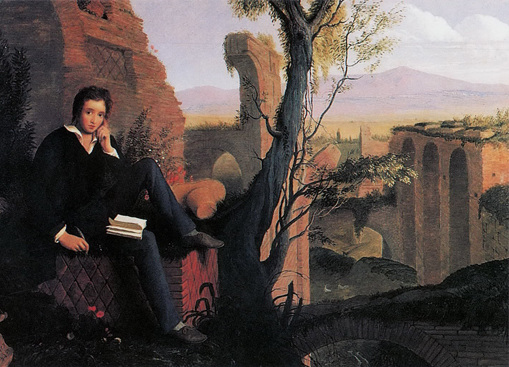
By Joseph Severn [Public domain], via Wikimedia Commons
1821
Keats dies in Rome; Shelley writes Adonais; Byron publishes Don Juan III–V; death of Napoleon; Thomas De Quincey’s Confessions of an English Opium Eater
On the 23rd February 1821 John Keats succumbed to tuberculosis in the bedroom of the apartment he had been renting in Piazza di Spagna. The tragic nature of his untimely death, at only 25, was further intensified by the fact that he died in ignorance of the acclaim that his work would one day receive. Keats’s poetry continues to touch innumerable numbers of people who, generations after his death, come from all parts of the world and all walks of life to visit the house where he died, now a place of pilgrimage and contemplation.
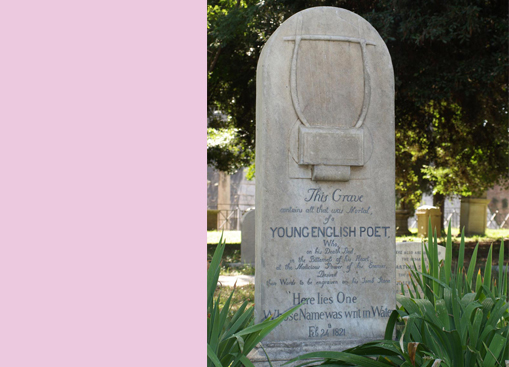
By Piero Montesacro (Own work) http://creativecommons.org/licenses/by-sa/3.0)], via Wikimedia Commons
1822
Death of Shelley; Schubert’s Symphony No.8(Unfinished)
Shelley drowned off the coast of Livorno on the 8th July 1822, less than one month before his 30th birthday. Suspicion surrounds the sinking of his boat, Ariel, which went down in a storm with two other hands on board. Some believe that Shelley scuppered the boat himself, in a selfish act of suicide, others that he was the victim of a pirate attack, or even that he was murdered for political reasons. His body was lost at sea for 11 days, and upon its retrieval was cremated on the beach at Viareggio. At the funeral Edward Trelawny, a friend of the poet, plucked what he took to be Shelley’s heart from the body and gave it to Mary Shelley, who kept it for the rest of her life in a heart-shaped box.
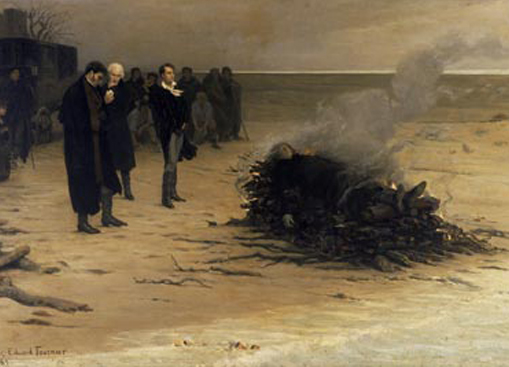
"The Funeral of Shelley by Louis Edouard Fournier" Licensed under Public Domain via Wikimedia Commons
1824
Death of Byron in Greece
On the 19th April 1824 Lord Byron died in a fit of fever in Messolonghi, Greece, where he had gone to aid the Greeks in their fight for independence from the Turks. He may have fallen ill with malaria and the customary cure at the time, bleeding, which would have been performed using unsterilized equipment, may have led to sepsis.
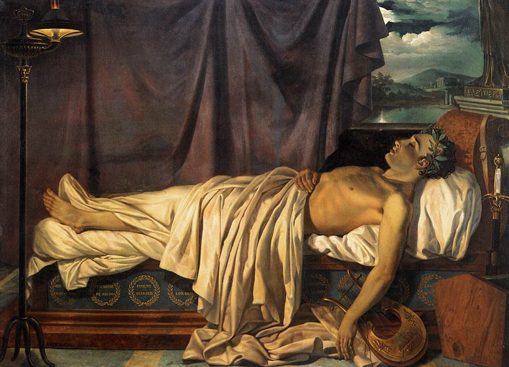
"Lord Byron on his Death-bed c. 1826" by Joseph Denis Odevaere. Licensed under Public Domain via Wikimedia Commons
1825
William Hazlitt publishes The Spirit of the Age
The Spirit of the Age, published in 1825, is a collection of essays written about a selection of individuals who either paved the way for the Romantic period or shaped its existence.
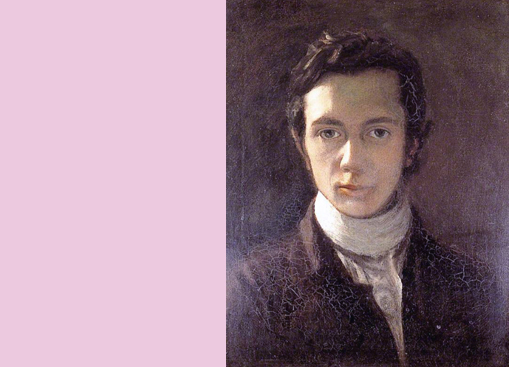
Licensed under Public Domain via Wikimedia Commons
1827
Deaths of Blake and Beethoven; Delacroix paints The Death of Sardanapaluse
In 1827 the Romantic movement suffered the loss of two of its finest champions, Blake and Beethoven.
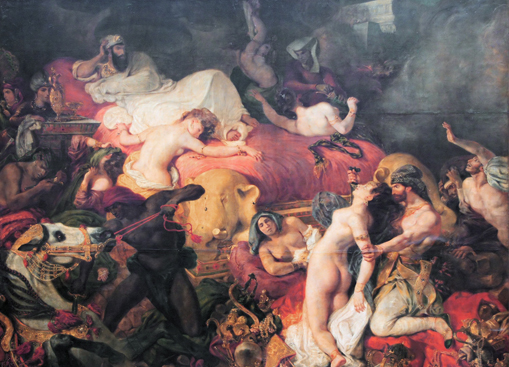
Licensed under Public Domain via Wikimedia Commons
1834
Death of Coleridge
Coleridge died from heart failure, allegedly induced by opium, on the 25th July 1834. He died in the house in Highgate, London, where he had been living as a guest of the physician James Gillman and his family for the past 18 years. Coleridge’s death sparked much debate about his life and poetic legacy.

Samuel Taylor Coleridge. Licensed under Public Domain via Wikimedia Commons
1837
Coronation of Queen Victoria
Victoria’s accession to the throne on the 28th June 1838 was the beginning of a 63 year long reign, the longest of any British monarch to date. The Victorian era marked a period of rapid industrial, military and political progress within Britain, and so it is at this point that literary historians often mark the end of the Romantic period.
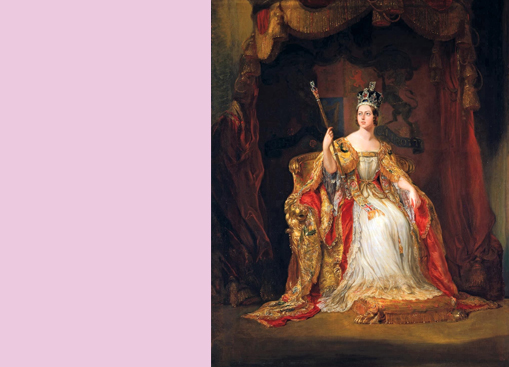
George Hayter under Public Domain via Wikimedia Commons